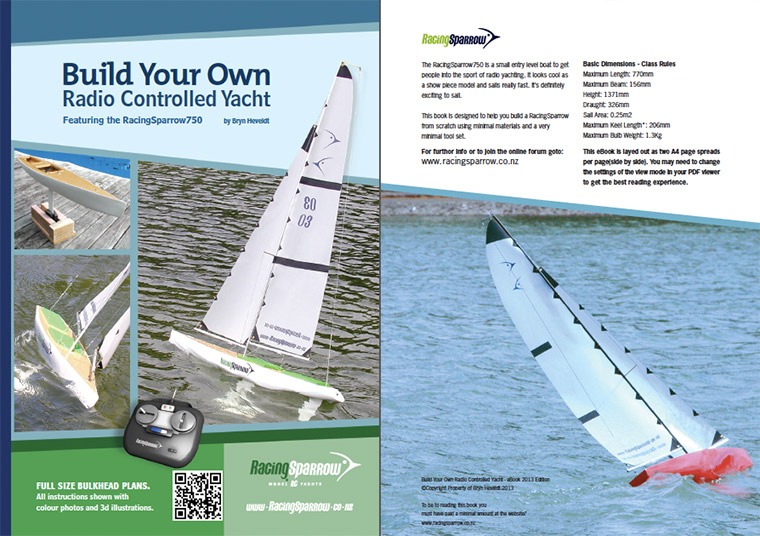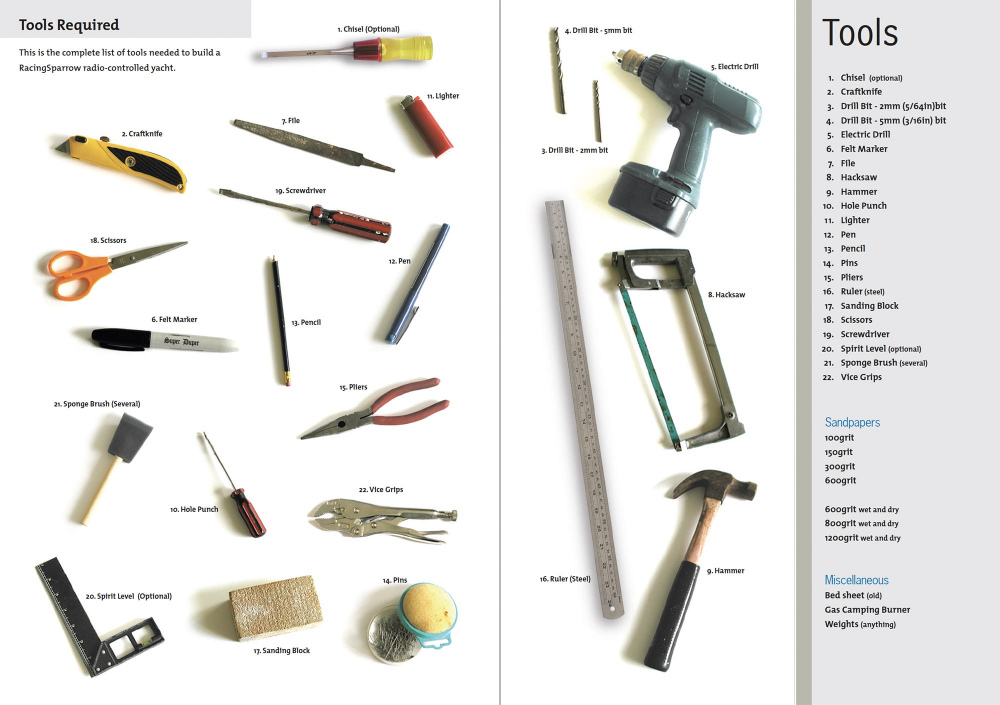What we cover in our boat building eBook
Download a sample of our eBook
Chapters include:
- Strip planking the hull.
- Fibreglass strengthening.
- Mould and casting lead keel ballast.
- Electrics installation.
- Spray painting and masking techniques.
- Sail making.
- Mast, rigging and tuning of sails.

Build Your Own Radio Controlled Yacht
This book is designed to help you build a RacingSparrow 750 from scratch using minimal materials and a very minimal tool set. When you buy the eBook you download a PDF version complete with detailed plans, clear illustrations and photos. It lists all tools & materials and shows centimeters & inch measurements.
Are there other plans I can build?
You can download these plans for free , 7 differing sizes and designs.
The techniques and materials detailed in the book can easily be adapted to the other plans to get a boat that suits your tastes. Along with the RS750 the other very popular boat is the RG65 designed RacingSparrow. The RG65 can be used to race and measures within the rules.
How much does it cost?
Some modellers manage to build for as little as $50. This might be someone who has some of the materials already or are good at repurposing old things. The authors boat cost around $300 including the radio gear. That was for all the materials described and used in the book.
Download some free pages from the book. View as Two-page view (in Chrome).

Anyone can build a Racing Sparrow
The book has been designed to make a quality model yacht. One that looks stunning, sails like it's on rails yet is playful and fun on the water. Also not cost the earth or require specialist tools.
What tools do I need?
Not that many as you can see in the picture. Those are all the tools used in this eBook. One less excuse to build that model boat you've always dreamt about. Get amongst it!

Common questions
Ordering and Downloading the eBook
When you purchase the eBook you will be redirected to a PDF download web page. After your transaction is successful it should redirect to this page. It can take a few seconds to clear the payment before it goes to the download page.
If for some reason you didn't get an immediate download please email info@racingsparrow.co.nz and I will email you the link personally.
What radio gear do I use?
For a radio-controlled sailboat in 2023, you need a transmitter, receiver, 4xAA battery holder, and 2 servos (1 for sail arm, 1 for rudder) that plug into the receiver using JR connectors. Waterproof options and different servo sizes for sail arm and rudder are abundant. You can choose from a range of transmitter and servo options, from simple to high tech.
The simple setup NZD$70(cheapest):
Transmitter & Receiver
Servos x 2
Battery Holder
Batteries
The mid-range setup NZD$230 (all waterproof):
Transmitter
Receiver
Sail arm servo
Rudder servo
Rechargeable battery
The no-limits setup: NZD$720
Transmitter
Receiver
Sail winch servo
Rudder servo
Rechargeable battery
Is it that hard to make a boat?
Is pouring lead within my skillset and safe?
Pouring lead can be a safe process as long as the proper equipment and precautions are taken. Heat and fumes can be a bit of a nuisance, but that's what gloves, goggles, and a mask are for! And don't forget to have a bucket of water on standby for added safety measures. Despite the potential hazards, many find pouring lead to be a rewarding aspect of the building process. Lead is a versatile and stable material that can be melted, molded, filed, sanded, and painted/coated with epoxy resin or primer. To acquire lead, consider looking for second-hand fishing sinkers or dive belts.
How much does it cost all-together to build a boat?
The radio gear and servos will set you back a few hundred, depending on what you end up buying and what needs you have. To start the project however, you really only need the balsa to build the hull. This will keep you quiet for some months. I'm willing to bet in that time you will spend time on the internet choosing components for your yacht including radio gear. You will need things like paint, resins and cloth, small aluminium lengths, lots of small and cheap parts which will add up. Most people doing this project may already have most of what they need. The toolset required is very simple. No specialist tools are needed. A craft knife and ruler will get used the most. You won't need to buy any special or expensive tools.
A budget between $300-500NZD would be realistic, this is spread out across typically a 6-12 month project. Fitting this in between the rest of your life!

Some of the boats people have built using this book. Awesome!
You can send us your images and we'll post them on this site.
LegoC 750
Jun 19, 2019


Martin Whittle, RS750, UK
May 1, 2011


Bradley, Kaiapoi
Dec 29, 2007


Alan Brown, Perth, West Australia
Jul 23, 2020


Hi Bryn
Jonathon Gillham, New Zealand
Oct 11, 2018


Julian Anthony, Kohuwala, Sri Lanka
Jun 4, 2021


'Sparrow' based RG 65
May 2, 2020


Jonathan Daniel
Oct 9, 2008


Rod Patterson, Christchurch, New Zealand
May 4, 2012


A reconditioned RS750 by the designer Bryn, New Zealand
Aug 3, 2009


You need some spare time, some patience, a little money spread over the project. The eBook project starts off cheap with simple balsa wood, knife and glue required. You could start by trying the small 375 hull to have a practice at planking. I promise you this planking thing gets addictive! With our eBook resource we take out the guesswork and have broken the project down into sensible components/milestones. The design of the hull is done in a way to keep things simple, functional and cheap.